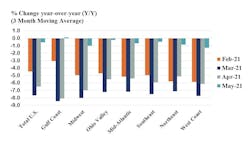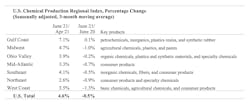ACC: US chemical production trend improves in May
WASHINGTON, June 28, 2021 (PRNewswire) — The U.S. Chemical Production Regional Index (U.S. CPRI), rose 4.6% in May following a 1.2% decline in April and a 3.4% drop in March, according to the American Chemistry Council (ACC). During May, chemical output rose in all regions, reflecting capacity restoration after the winter storms along the Gulf Coast. The U.S. CPRI is measured as a three-month moving average (3MMA). It includes the Federal Reserve's recent benchmark revision, whose base year is now 2017.
Chemical production was mixed in May, with an improving trend in production of organic chemicals, plastic resins, chlor-alkali, adhesives, coatings, fertilizers, crop protection chemicals, other specialty chemicals, and miscellaneous inorganic chemicals. These gains were offset by continued weakness in synthetic rubber, synthetic dyes and pigments, manufactured fibers, and consumer products.
As nearly all manufactured goods are produced using chemistry in some form, manufacturing activity is an important indicator for chemical demand. Following a small decline in April, manufacturing output rose in May, by 1.0% (3MMA). The 3MMA trend in manufacturing production was mixed, with gains seen in the output of food and beverages, appliances, aerospace, machinery, fabricated metal products, computers and electronics, semiconductors, oil and gas extraction, refining, iron and steel products, foundries, rubber products, paper, printing, and furniture.
Compared with May 2020, U.S. chemical production remained off by 0.5%, reflecting the lingering impact of March's freeze damage. Chemical production was lower than a year ago in all regions except the Gulf Coast, which turned slightly positive.
The chemistry industry is one of the largest industries in the United States, a $565 billion enterprise. The manufacturing sector is the largest consumer of chemical products, and 96% of manufactured goods are touched by chemistry. The U.S. CPRI was developed to track chemical production activity in seven regions of the United States. The U.S. CPRI is based on information from the Federal Reserve and includes monthly revisions as published by the Federal Reserve. The U.S. CPRI includes the most recent Federal Reserve benchmark revision released on May 28, 2021.
To smooth month-to-month fluctuations, the U.S. CPRI is measured using a three-month moving average. The reading in May reflects production activity during March, April, and May.

